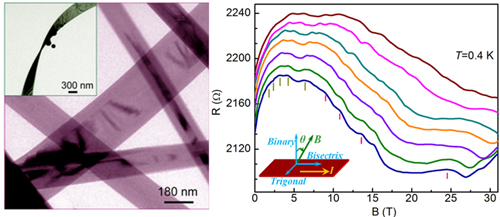New progress on the surface states investigation of bismuth single-crystal nanoribbons have made by the group of Prof. Tian mingliang from the High magnetic Field Laboratory, Chinese Academy Sciences. Their experimental results provided unambiguous transport evidence of the topological 2D metallic surface states in bismuth nanoribbons.
Semimetallic bismuth is a fascinating material with low carrier density, small effective mass and long mean free path, which distinguishes it from other metals as particularly suitable for studying quantum phenomena. The surface states of Bi have also attracted many interests due to its strong spin-orbital interaction and in relation to the Bi-based topological insulators (Bi1-xSbx, Bi2Se3, Bi2Te3). It was found that the surface of an ultrathin Bi bilayers is quite distinct from the bulk semimetal but can be viewed as a quasi-two-dimensional (2D) metal with unique spin properties. However, the origin of the surface states is still under exploring.
Recently, the researchers have performed angular-dependent magnetoresistance (AMR) measurements on individual single-crystal Bi nanoribbons of different thickness with magnetic field up to 31 T. In thin nanoribbons with thickness of ~40 nm, a two-fold rational symmetry of the low field AMR spectra and two sets of 1/2-shifted (i.e. =1/2) Shubnikov-de Haas (SdH) quantum oscillations with exact two- dimensional (2D) character were obtained. However, when the thickness of the ribbon increases, a 3D bulk-like SdH oscillations with =0 and a four-fold rotational symmetry of the AMR spectra appear. These results unambiguously provided the first transport evidence of the topological 2D metallic surface states in thinner nanoribbons with an insulating bulk.
These observations provide a promising pathway to understand the quantum phenomena in Bi arising from the surface states. This work recently was published online in the journal of ACS Nano. The project is supported by the National Science Foundation, the Ministry of Science and Technology of China, and the Chinese Academy of Science
|
 |
|
Left: TEM image of single-crystal Bi nanoribbons;
Right: Quantum oscillations of a individual nanoribbon with thickness of 40 nm under high magnetic field. |
Paper link: http://pubs.acs.org/doi/full/10.1021/nn502813y